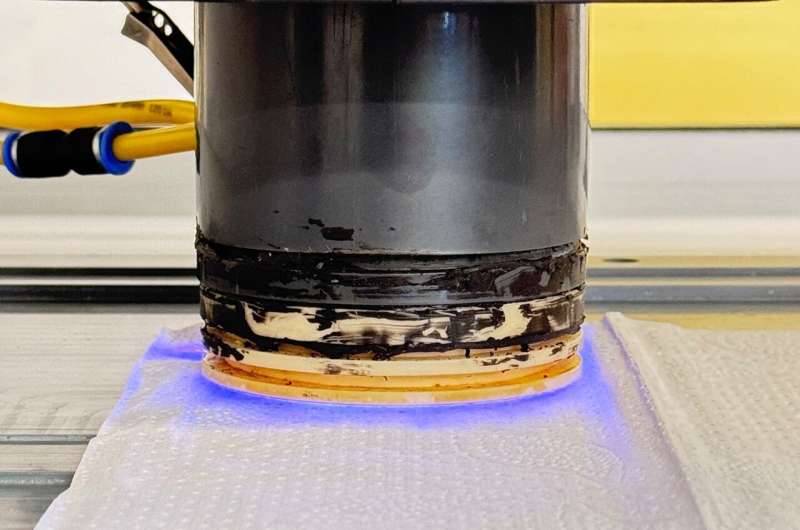
Plastic waste, harmful to the
environment, has been increasing continually in Germany in recent years.
Packaging generates particularly high volumes of waste. Plant-based coatings
for paper packaging could provide a sustainable alternative in the future.
In the BioPlas4Paper project, researchers from the Fraunhofer Institute for Surface Engineering and Thin Films IST and project partners have used a coating process known as plasma polymerization to create water-repellent and plant-based barrier coatings on paper, thereby improving the paper's resistance to the effects of the weather.
Plastic packaging continues to be a major problem for the environment. Paper, on the other hand, is made of renewable raw materials. Its advantage over petroleum-based plastic is that it decomposes and does not remain in the ground for many years.
However, uncoated paper does not provide any barrier to humidity or oxygen. Plain paper is sensitive to temperature, reacts strongly to moisture and bacteria, and is characterized by uneven surfaces.
To fully exploit the potential of the material, improve recycling options, replace plastic packaging and tap into new fields of application, we need to improve the service life, durability and quality of paper products.
This is the task that researchers from Fraunhofer IST are dedicating themselves to in the BioPlas4Paper project, working closely with the Technical University of Darmstadt and the Thünen Institute of Wood Research.
In order to create homogeneous, moisture-repellent coatings on paper, the project partners are focusing on plant substances such as oregano and chia oil as well as on extractive material obtained from bark. Among other properties, these plant substances exhibit antibacterial effects.
Bio-based plasma polymers crosslink with the surface of the paper
"So far, we have been using untapped plant substances with a high proportion of unsaturated fatty acids to make the paper hydrophobic, i.e., water-repellent. For this, we employ atmospheric pressure plasma technology, where gas is excited with high voltage under ambient pressure to generate plasma, i.e., a particle mixture of ions, free electrons and, in most cases, neutral atoms or molecules. The process causes a discharge between the electrodes," says Martin Bellmann, a researcher at Fraunhofer IST in Braunschweig.
The addition of nitrogen converts the plant substances into an aerosol and introduces this into the plasma as vaporized organic precursors to form polymer networks.
Experts refer to this process, in which the precursors are activated by the plasma, as plasma polymerization. The micrometer-sized particles join together to form plasma polymers. The tiny droplets also crosslink with the paper and spread evenly over the raw paper substrate, penetrating deep into the pores and fibers of the surface.
"The plasma is essential in making the plant molecules reactive and enabling them to crosslink into polymers," Bellmann explains.
Innovative plasma source concept
The plasma is created using a plasma source by ionizing gas between two rotationally symmetric electrodes to which high voltage is applied. New is the geometric arrangement of the electrodes and the method by which the aerosol is introduced and the plasma is ignited.
The combination of these measures produces an innovative concept that the researchers have developed specifically for the project, allowing—under atmospheric pressure—the effects of ambient air to be minimized even at higher coating speeds, while maintaining consistent and reproducible results.
"At high processing speeds, the roughness of the paper's surface causes turbulence in the ambient air, altering the properties of the plasma. We can avoid these detrimental effects with our concept," says Bellmann.
The plasma source is introduced close to the paper's surface, completely displacing the ambient air as a result. The researchers work with plasma temperatures of around 70 degrees Celsius so as not to affect the paper itself, the bio-based precursor molecules, or the properties of the plasma polymers being produced.
Water-repellent coatings made with olive oil
Numerous tests involving a wide range of plant oils and extracts have enabled the researchers to demonstrate that bio-based materials can be separated or deposited reproducibly and homogeneously using plasma.
Excellent hydrophobic coatings can be achieved with olive oil and chia oil, for example. Depending on the precursors used and the coating parameters, the researchers can influence and optimize the coatings. The aim is to prepare paper for increasingly sophisticated use cases and, in the future, to even replace plastic materials.
"One example is moving boxes, which, with our hydrophobic coatings, can withstand even extended periods of rain without becoming soft. Our objective is to reduce dependence on fossil resources and support the transition to a resource-efficient economy," says Bellmann.

 Previous page
Previous page Back to top
Back to top







